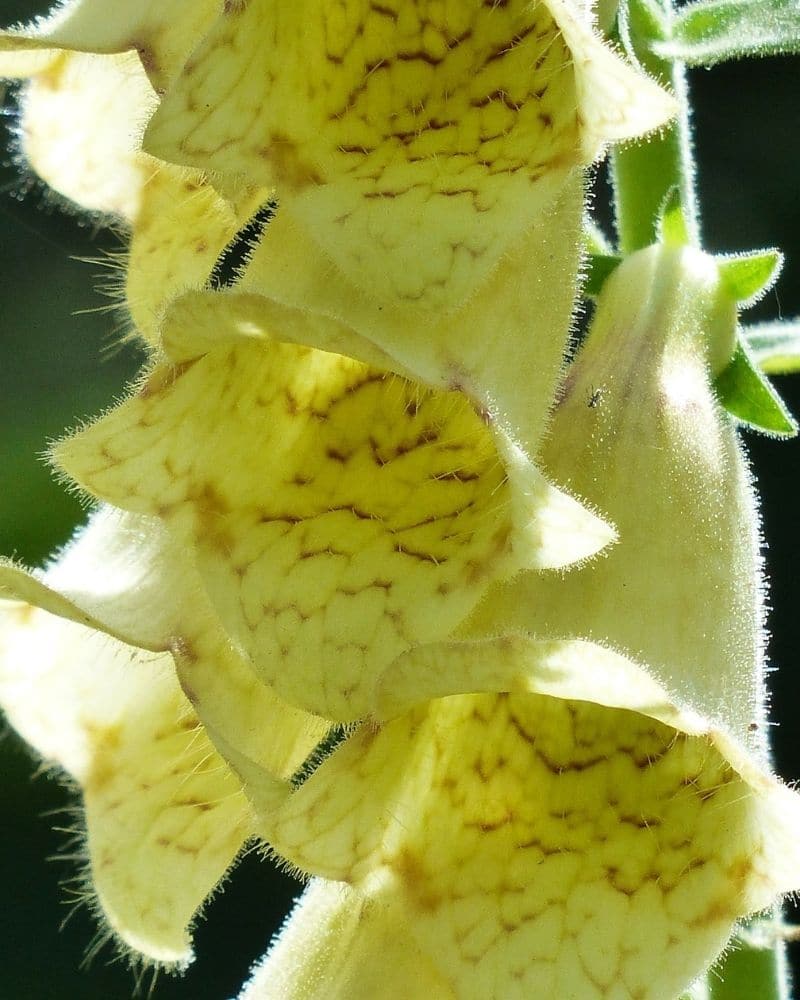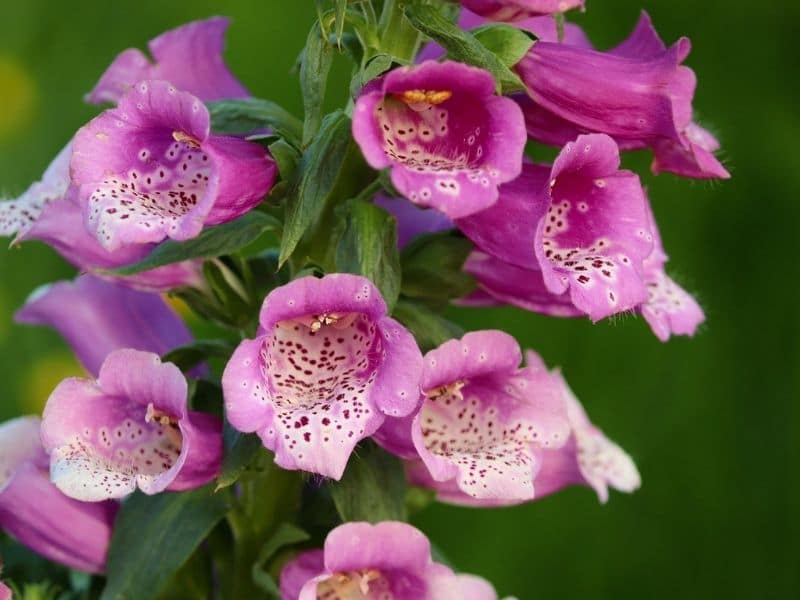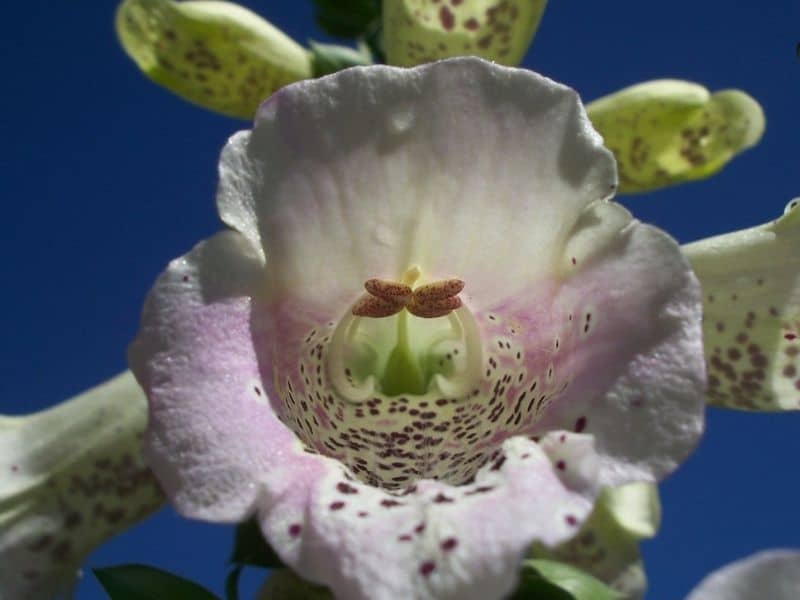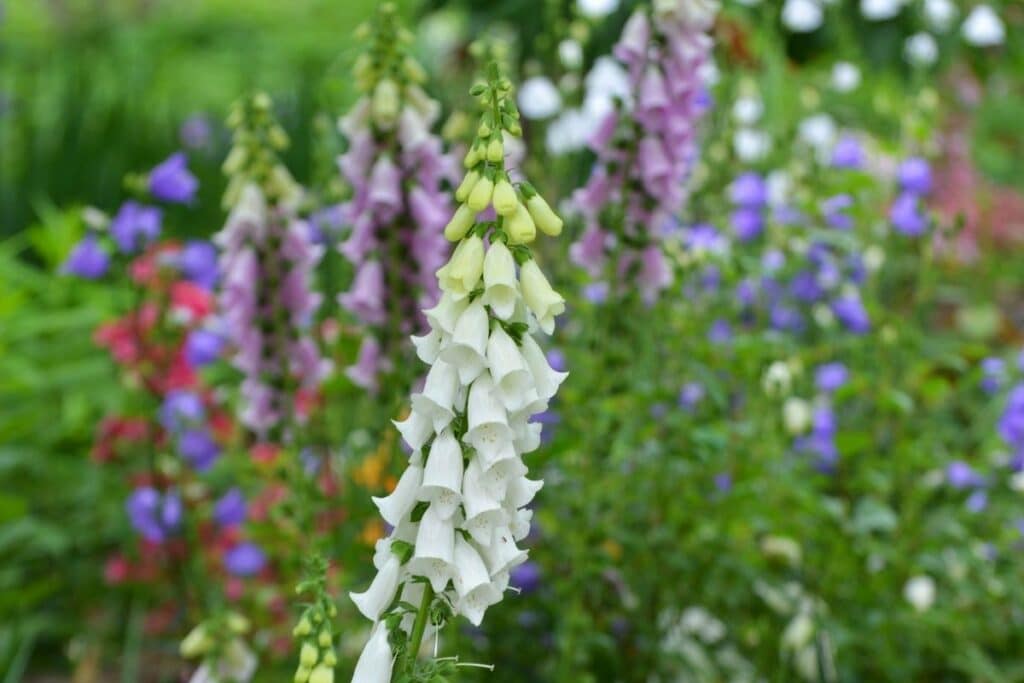Foxglove flowers belong to the family of plants Plantaginaceae. They are native to Europe, more specifically to the Mediterranean region, although nowadays, they can be easily found in many other countries.
- Basic Facts about Foxglove Plant
- How To Care for Foxgloves
- Types of Foxglove Flowers You Can Grow
- Apricot Beauty
- Camelot Rose
- Café Creme (Digitalis lanata)
- Camelot Lavender
- Camelot White
- Digitalis grandiflora
- Digitalis purpurea
- Dalmatian Crème Hybrid
- Dalmatian Peach Hybrid
- Digiplexis “Illumination Flame”
- Digitalis x mertonensis
- Digitalis ‘Goldcrest’
- Digitalis obscura
- Excelsior Hybrid (Digitalis purpurea)
- Foxy
- Giant Yellow Herod (Digitalis ferruginea)
- Milk Chocolate (Digitalis parviflora)
- Monstrosa (Digitalis purpurea)
- Pantaloons (Digitalis purpurea)
- Polka-Dot Hybrid
- Ruby Glow
- Snow Thimble (Digitalis purpurea)
- Straw Foxglove (Digitalis lutea)
- Sugar Plum (Digitalis purpurea)
- Yellow Spear
- Frequently Asked Questions about Foxglove Plant
Foxglove flowers have bright and colorful flower spikes, which makes this type of flower a very interesting-looking one! Tall and hardy, the Foxglove flower is a safe option for those who want to have a ‘’wow factor’’ in their garden.
Continue reading about foxglove flowers and discover everything you need to know about them!
Basic Facts about Foxglove Plant
- Foxglove flowers are also referred to as Digitalis purpurea and can come in several colors, such as purple, red, yellow, pink, white, cream, and pink. However, the most common varieties are pink and purple colors.
- All foxglove varieties have darker spots all over the blooms.
- This plant has long stems that could reach more than 6 feet in height; foxglove leaves need plenty of sunshine to thrive, although some varieties could be placed under partial shade.
- Foxglove is a biennial and wildflower; in other words, they are sown and grow within the first year, then the second year they will flower and will die soon after seeding.
- However, there are some varieties of foxglove flowers that will continuously bloom well past the second year mark. If this is the case, then these types of flowers are referred to as herbaceous perennials.
- An interesting aspect of foxglove flowers is that they produce fruits that have dry and small capsules inside, where all the seeds can be found.
- Foxglove’s blooms will usually face down.

How To Care for Foxgloves
Foxgloves are wild flowers, which means they will thrive regardless of the external influence they may receive. However, gardeners should follow certain tips in order to grow foxgloves successfully:
How to Grow Foxglove Flowers
Growing foxgloves is a straightforward process. Foxglove plants need well drained soil that will allow them to eliminate the excess water.
These perennial foxgloves can be grown directly from seed, or they can be left alone to reseed themselves.
Either way, the new plants or seedlings should be cut and placed within a space that has—at least—20 inches of separation within two plants; otherwise, they will grow close to one another, and this could hinder their development.

Light Requirements
Foxglove plants thrive in a variety of lighting conditions. They prefer full sun or light shade for optimal growth and beautiful pastel petals. Ideally, plant foxgloves in an area that receives at least three to six hours of direct sunlight per day.
While they perform well under a wide range of lighting conditions, those exposed to full sun will produce the strongest blooms.
However, foxgloves also benefit from shade during the hottest parts of the day, which doesn’t negatively impact foxgloves flower production.
Watering Requirements
Keep the soil moist but not waterlogged. Aim for a balance between dryness and saturation. When you squeeze the soil between your fingers, it should feel damp but not dripping.
Water foxgloves when the top inch of soil starts to dry out. Depending on the weather and soil type, this may occur approximately once a week during the growing season.
Avoid overwatering because Foxgloves are susceptible to root rot if the soil remains excessively wet.
Apply a layer of organic mulch around the base of the plants to retain moisture and regulate soil temperature.
Temperature Needs
Although foxgloves will thrive when they receive full sunlight, this does not mean that they prefer hot climates. On the contrary, foxgloves will do better if they grow at a relatively cool temperature.
Fertilizer
Foxgloves are wildflowers; thus, they do not need fertilizers to thrive. If you would like to fertilize it, try using a completely organic fertilizer.
Propagation
The good thing about foxglove plants is that they will reseed themselves, most of the time if their growing conditions have been met.
A gardener may think that the same plant is reappearing year after year when in reality, the oldest plant has reseeded itself, and now new plants are emerging.

Types of Foxglove Flowers You Can Grow
Here are some foxglove varieties you can grow:
Apricot Beauty
This foxglove flower has light peach blooms. They can grow up to 4 to 5 inches in height; and they welcome all different types of pollinators.
Camelot Rose
Although its name suggests that this flower is pink, these blooms are actually dark purple. The Camelot rose variety has longer petals than the rest of the foxgloves.
Café Creme (Digitalis lanata)
Also referred to as woolly foxglove, Café Creme has very distinctive blooms, as one part of them is white and the other is cream or brown. They are also called Grecian foxgloves because they are native to Greece.
Camelot Lavender
This type of foxglove has very dark purple petals. They belong to the common foxglove variety or digitalis purpurea. The Camelot lavender is hardy and sturdy and will thrive even in a hot climate.
Camelot White
This type of foxglove can grow up to 4 feet in height. They have white large petals, and unlike other varieties, their inside spots are of a light color.
Digitalis grandiflora
The Digitalis grandiflora plant has yellow petals and darker spots inside these petals. They have a tubular shape. This variety of foxglove grows on bushy slopes, and it prefers colder climates.
Digitalis purpurea

This variety is the most famous one of the foxgloves. They can be purple, pink, or white. Digitalis purpurea has long, glossy stems, and they can reach up to 5 feet in height.
Dalmatian Crème Hybrid
As its name suggests, this type of foxglove has pink dots that make it look like a dalmatian dog. They are very beautiful, and if all the right conditions are met, they will bloom for two to three years.
Dalmatian Peach Hybrid
Most dalmatian foxgloves varieties have one or two different hybrids. The dalmatian peach hybrid is one of them. The difference is that their petals are peach and pink, and they have inner peachy spots.
Digiplexis “Illumination Flame”
Another hybrid foxglove, the Digiplexis foxglove is a combination between the common digitalis and the Digitalis relative, which comes from the Canary Islands. Its petals are bright orange, and they are sterile, therefore, the seeds they produce will not grow.
Digitalis x mertonensis
This strawberry foxglove is a hybrid plant. It is a combination of the digitalis grandiflora variety and the digitalis purpurea. Their main difference is that they have the height of the grandiflora and the color of the purpurea.
Digitalis ‘Goldcrest’
This foxglove variety is very difficult to find. They have pink, orange, and yellow flowers.
Digitalis obscura
Another difficult to find foxglove variety, this type has orange blooms. They can grow up to 5 feet in height.
Excelsior Hybrid (Digitalis purpurea)
This type of foxglove catches everyone’s attention! It is beautiful, tall, and will produce many more similar plants if the right growing conditions have been met.
Foxy
The foxy foxglove has smaller petals in comparison to other types of foxgloves. However, they produce more flowers than the rest of the foxgloves! They can grow up to 3 feet in height.
Giant Yellow Herod (Digitalis ferruginea)
Definitely one of the most-interesting looking plants on this list, the Giant Yellow Herod has a larger stem than the rest of foxglove flowers, and they will bloom throughout the hottest summer days.
Milk Chocolate (Digitalis parviflora)
As its name suggests, this variety of foxglove has a brown milk chocolate color. They even look tasty! However, they are highly poisonous.
Monstrosa (Digitalis purpurea)
One of the biggest types of foxglove, this variety can reach 5 feet in height. They are very sturdy and will survive even the hardest weather.
Pantaloons (Digitalis purpurea)
Also referred to as Pam’s split, Pantaloons, unlike other varieties, have burgundy stains and not spots inside the petals. They will reproduce rapidly if left unattended.
Polka-Dot Hybrid
They are one of the most resistant foxgloves in nature, mainly because they will bloom for a long time. Its petals are very bright and colorful, and they can grow up to 50 inches high.
Ruby Glow
Another recently-introduced hybrid, Ruby Glow has vibrant pink or ruby petals, and it is usually sold as an ornamental plant.
Snow Thimble (Digitalis purpurea)
As its name suggests, this type of foxglove is white both on the inside and the outside. In fact, it is one of the few foxglove flowers that do not have spots on the inside. They can grow up to 6 feet in height and are very hardy, especially throughout winter.
Straw Foxglove (Digitalis lutea)
Unlike other foxgloves, this variety only produces a couple of petals or flowers. They only grow up to 3 feet in height, which also makes them one of the shortest types of foxgloves.
Sugar Plum (Digitalis purpurea)
This variety has plum petals, hence its given name. They will go amazingly well with other types of foxgloves, as they will all complement one another. They will bloom throughout late spring and early summer.
Yellow Spear
Yellow Spear have very soft yellow petals. As its name suggests, the spikes of this flower resemble a spear, albeit a non-deadly one!
Frequently Asked Questions about Foxglove Plant

Here are the most frequently asked questions about the exotic foxglove flowers:
Does foxglove come back every year?
Yes, foxglove (Digitalis) is a biennial or short-lived perennial plant, meaning it typically comes back every year from its base foliage.
How do you keep foxgloves blooming all summer?
To keep foxgloves blooming all summer, deadhead spent flowers regularly to encourage continuous blooming. Provide them with adequate water and ensure they are planted in well-draining soil with sufficient sunlight.
What do you do with foxgloves after flowering?
After foxgloves finish flowering, cut back the flower spikes to the base of the plant to encourage new growth and potential reblooming in the next season.
Do foxgloves spread?
Yes, Foxgloves can spread through self-seeding if allowed to go to foxglove seed. Deadheading spent flowers can prevent excessive self-seeding and help control their spread.
Is foxglove poisonous to dogs?
Yes, Foxgloves are poisonous to dogs if ingested, containing compounds that can cause gastrointestinal distress, vomiting, diarrhea, irregular heartbeats, and even heart failure. It’s essential to keep foxgloves away from areas accessible to pets.
Why are my foxgloves falling over?
Foxgloves may fall over due to various factors, including wind, heavy rain, improper staking, or weak stems. Providing support with stakes or pruning to encourage thicker stems can help prevent them from falling over.
Conclusion

Foxglove flowers are known for their colors, shape, length, and strength. But, what strikes gardeners the most is how this flower is so classic, stylish, and elegant, and how they can bring a garden into life! It’s one of the best flowers gardeners can grow.
Foxgloves can make a huge statement if they are planted one next to another one, in close proximity. But they will also look amazingly well if you plant them at the back of the cottage gardens, and you can make several rows with diverse types of flowers and a wide range of colors! The choices are endless!
Up Next: Foxglove Flower Meaning and Symbolism
*Image by depositphotos.com/orestligetka.ukr.net







